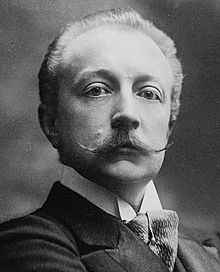Plastron (civil clothing)

A plastron ( pronunciation : [ ... ˈtrõː ], Austrian [ ... ˈtroːn ]) is a wide (white) tie or a bib in women's costumes.
The wide tie, and tie scarf , Ascot , Ascot tie or English day cravat ( Day Tie ), is one of the forerunners of today's long binder tie .
history
The plastron was developed around 1860 from several tie knots laid one on top of the other . It was and is worn with a cutaway , later also with a frock coat , and in 1920 it was replaced by the narrower long tie , the tie that is common today.
The names Ascot and Ascot tie come from the famous British horse race Royal Ascot Race , in which men wear the plastron with a classic cutaway.
today
Apart from the cutaway , the plastron is almost only worn in equestrian sports today . However, the ready-tied models with Velcro fasteners and buttons have prevailed among the tournament riders .
Today, the self-tied plastron is mainly found on traditional hunting riders. In addition to its fashionable character, the plastron always had a practical use in hunting: it can be used as a dressing material for dogs, horses and riders, it can be used as a leash for a dog and leather items can also be repaired in a makeshift manner.
In addition, the ascot tie is used in wedding attire, then in combination with a three-piece suit or a wedding vest. At weddings, the male guests should not be dressed better or more festive than the groom. If the groom does not wear a plastron but a tie, bow tie or bow, the guest should refrain from wearing a festive plastron. If the groom wears a plastron, the guest can also wear a (more subtle) plastron. In Great Britain and the USA it is good form to wear a plastron for a cut .
